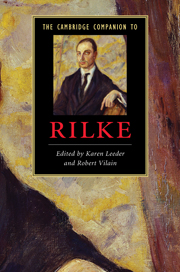1 - Rilke: a biographical exploration
from PART I - LIFE
Published online by Cambridge University Press: 28 July 2010
Summary
Among the stunning array of German-speaking writers and intellectuals around 1900 the poet Rainer Maria Rilke was perhaps the most cosmopolitan, only matched in his worldliness by his friend and compatriot, Stefan Zweig. Even though Rilke's actual knowledge of the world was mainly confined to continental Europe, except for his journey to North Africa in 1910-11, and firmly excluded the Anglo-Saxon sphere, of whose blunt materialism he remained suspicious until the end of his life, the poet's outlook was decidedly international and anti-chauvinistic, and he remained open-minded towards other cultures until the end of his life. His horizon as traveller and reader stretched from Bohemia to Russia, France to Scandinavia, Italy to Egypt, and from Spain to Switzerland and their respective literatures. He was a migrant and a belated troubadour, at times a vagrant revered, if not idolised, by aristocrats, industrialists, fellow artists and artisans alike, and eventually recognised by anyone able to appreciate German poetry as probably its most sublime master after - or even alongside - Goethe, Hölderlin and Heine.
There was something anachronistic about this poetic artist even though his art was quintessentially modernist in style and poetic approach without ever disregarding, or disowning, tradition. Bach, Beethoven and Nietzsche influenced him as much as Rodin, Cézanne, Klee and Picasso. He studied eclectically, if not erratically, and liked to read the Grimm brothers' German dictionary like a novel. His life was full of rich experiences that were without exception intimately connected with art. His creed was that life and art should serve each other.
- Type
- Chapter
- Information
- The Cambridge Companion to Rilke , pp. 9 - 26Publisher: Cambridge University PressPrint publication year: 2010



